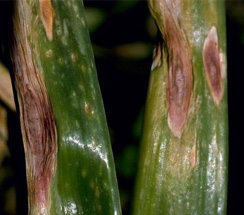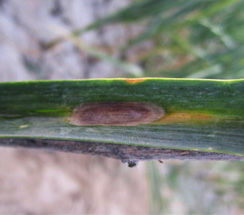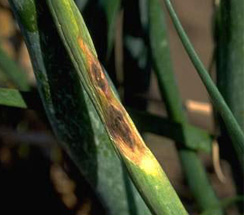| Purple blotch/scald disease: Alternaria porri |
Symptom:
- Leaves - whitish minute dots on leaves with irregular chlorotic areas on tip portion
- Circular to oblong concentric black velvety rings appear in chlorotic area
- Lesions develop towards the base of the leaves
- Leaves die from the tip downwards, break at the point of infection and hang down
- Bulbs – semi watery rot, shrinkage of the fleshy bulb scales and desiccation followed by these scales becoming dry and papery
|
| |
 |
 |
 |
| |
Whitish small dots |
Circular concentric black ring |
Purple blotch |
|
Identification of pathogen:
- Mycelium - branched, coloured and septate
- Conidiophores - singly or in groups, septate, pale to mid brown
- Conidia - solitary, straight or curved
Mode of spread and survival:
- Carried through seed bulbs collected from infected field
- Spreads mainly through air borne spores
- Pathogen enters through stomata or wounds
- Survives in plant debris for 8 months
Epidemiology:
- Temp - 21 to 30oc
- RH - 90 %
|
Management:
- Seed treatment - thiram @ 2.5g/kg of seed
- Three sprays of Copper oxychloride - 0.25%, Chlorothalanil - 0.2% and Zineb - 0.2%
- Mancozeb - 0.2%
- Varieties - New Selection, Red Creole - resistant
|
Source of Images:
http://www.apsnet.org/publications/imageresources/Pages/fi00190.aspx
http://www.ipm.ucdavis.edu/PMG/A/D-OG-APOR-FO.001.html
|



